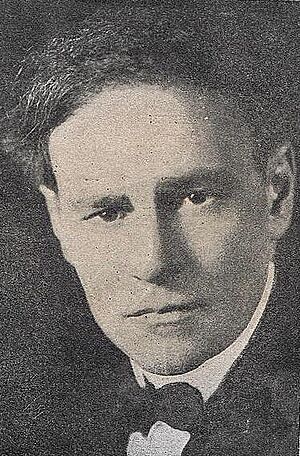Eduardo Fabini facts for kids
Eduardo Fabini (born in Solís de Mataojo, Uruguay, on May 18, 1882 – died May 17, 1950) was a very important Uruguayan composer and musician. He is known for his unique style.
Fabini was part of a group of composers who created a "nationalist" style in Uruguayan music. This style became popular in the 1910s and 1920s. Other composers in this group included Alfonso Broqua and Luis Cluzeau Mortet. They wanted their music to sound like Uruguay.
Contents
Biography
Eduardo Fabini was born on May 18, 1882, in a small town called Solís de Mataojo. His parents, Juan Fabini and Antonia Bianchi, were from Italy. There were also some talented musicians in their family. Eduardo grew up close to nature, which later inspired his music.
People consider Fabini to be one of Uruguay's best classical musicians. He started by learning classical music forms. Then, he mixed these with sounds and melodies from Uruguayan folk music. This made his music very special and beautiful.
Fabini started learning music when he was very young. When he was four, his favorite toy was an accordion. At six, he loved playing the harmonium. He began violin lessons with his older brother. Later, he studied in Montevideo at "The Lyre" Conservatory. His teachers there included Romeo Massi and Italo Casellas.
In 1899, when he was 17, Fabini won a scholarship. This allowed him to travel to Europe. He studied at the music conservatory in Brussels. There, he learned violin from teachers like deloc and Thomson. He also studied harmony with teacher Brouk.
While in Brussels, Fabini started composing. He wrote "Tristes" for orchestra and "Flowers of the field" for choir. He also won the First Prize for Violin at the Brussels Conservatory. Fabini was the first South American to share his native music in that European setting.
He returned to Uruguay in 1903. He performed as a solo violinist at the Teatro Solís in Montevideo. His performances were greatly admired. After another trip to Spain in 1905, he came back to Montevideo in 1907. He helped start the Musical Conservatory of Uruguay in 1907. In 1913, he also helped create the Association of Chamber Music. This group organized many concerts where he performed.
Later, Fabini chose to live a quieter life in the countryside. He stayed in Solís and Fuente Salus. During this time, he composed "Campo" (meaning "Countryside"). This was his first symphonic poem. A symphonic poem is a piece of orchestral music that tells a story or describes a scene.
"Campo" was first played in Montevideo in 1922. It quickly became very famous. It was also performed in Buenos Aires in 1925 by the Vienna Philharmonic. Soon, it was heard in New York, Washington, Madrid, and other major cities. Even the famous conductor Richard Strauss led the Vienna Philharmonic in playing "Campo."
Because of this success, Fabini kept composing. He created music that sounded like the Uruguayan countryside. Soon after "Campo," he presented another symphonic poem called "The Island of Ceibos." His other works include many songs and school choirs. He also wrote a fantasy for violin and orchestra. Some of his ballets are "Mburucuyá" and "Mañana de Reyes" (for children).
In 1927, he became an Artistic Attaché at the Uruguayan Embassy in the U.S. He moved to New York City. There, "Campo" and "The Island of Ceibos" were recorded by the Philharmonic Orchestra. These recordings were released by Victor Records.
Eduardo Fabini passed away in May 1950. He had a heart condition. Many schools in Uruguay are named after him. These include the Instituto Eduardo Fabini and the Lyceum Mataojo Solis.
Style
Román Viñoly Barreto, a writer, said that Fabini's music was very honest. He wrote music the way he felt it. He didn't try to show off his technical skills. Other experts, Salas and Pauletto, added that Fabini was a "nativist" musician. This means his music was deeply connected to his home country and its culture. He was also known for being simple and modest.
Works
Symphonic music
- Poema sinfónico Campo
- La isla de los Ceibos
- Fantasía para violín y orquesta
- Mburucuyá, ballet
- Melga sinfónica
- Mañana de Reyes, ballet for children
Choir and orchestra
- La patria vieja
- Las flores del campo
- El Rancho
- A mi Rio
- El Arroyo descuidado
- La Güeya, canción
- El nido
Singer and piano
- Luz mala
- El Tala
- La flores del monte
Piano solo
- Dos tristes
- Estudio arpegiado
- Intermezzo
- Scarlattina
- Sarandí en la corriente
- Atlántida
Discography
- Eduardo Fabini y María Luisa Fabini de West. (Orfeo ULP 2765)
- Las cinco grandes obras sinfónicas (Ayuí / Tacuabé t/m12cd. 1998)
- Grabaciones Históricas de su obra Volumen 2 & 3 (Ayuí / Tacuabé tm15-16 cd)
See also
 In Spanish: Eduardo Fabini para niños
In Spanish: Eduardo Fabini para niños


